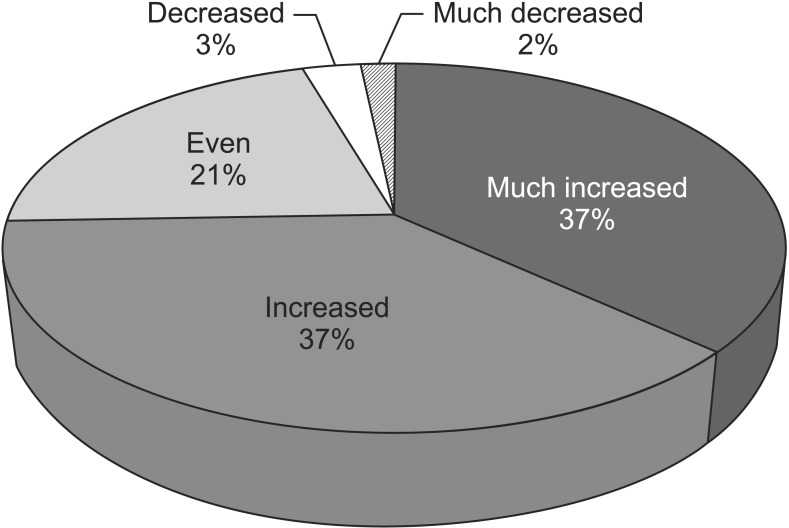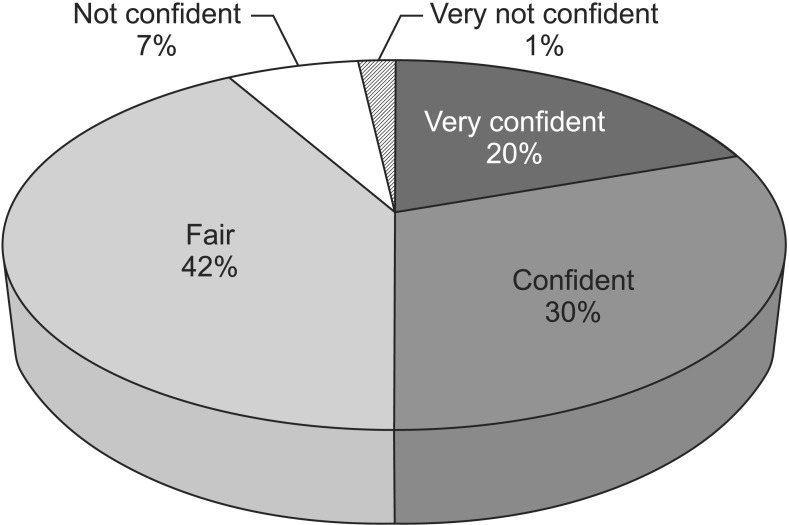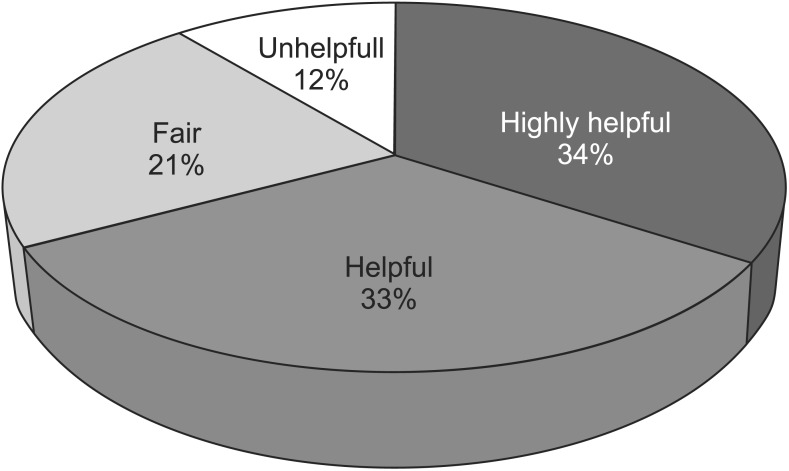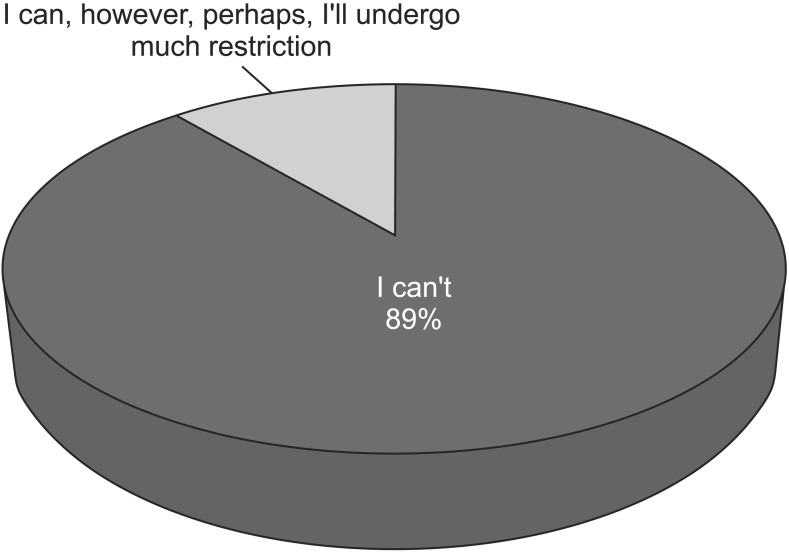Ann Rehabil Med.
2015 Apr;39(2):277-284. 10.5535/arm.2015.39.2.277.
Necessity to Develop a Tool to Evaluate Activity of Daily Living for Electric Powered Indoor/Outdoor Chair Users
- Affiliations
-
- 1Department of Rehabilitation Medicine, Konkuk University School of Medicine, Chungju, Korea. kimnerve@hanmail.net
- 2Department of Neurology, Konkuk University School of Medicine, Chungju, Korea.
- 3Department of Neurosurgery, Konkuk University School of Medicine, Chungju, Korea.
- KMID: 2273050
- DOI: http://doi.org/10.5535/arm.2015.39.2.277
Abstract
OBJECTIVE
To evaluate changes in activity of daily living before and after provision of electric-powered indoor/outdoor chair (EPIOC), discuss problems of current activities of daily living (ADL) evaluating tools for EPIOC users, and provide preliminary data to develop ADL evaluation tool for EPIOC user.
METHODS
A total of 70 users who were prescribed EPIOC and had been using for more than 1 year were recruited in this study. Before and after provision of EPIOC, MBI and FIM scores were measured and a questionnaire consisting of six categories (general socioeconomic states, currently using state, whether EPIOC was helpful for social participation and occupational chances, psychiatric influences, self-reported degrees of independency, and barriers of using EPIOC) was used.
RESULTS
No difference in MBI scores before and after provision of EPIOC was observed. However, the wheelchair ambulation category showed a significant difference. While motor FIM was not significantly different from MBI, FIM score were significantly (p<0.05) higher than MBI. For questions regarding social participation frequency, helpfulness of EPIOC on confidence, refreshing patients' emotions and self-reported degrees of independence, all of them showed positive responses. Especially, EPIOC users' self-reported degree of independency showed favorable results. There was discrepancy in MBI or FIM measured by physicians.
CONCLUSION
Our study showed that there was a gap between the existing ADL evaluation tool and the ADL level that EPIOC users were actually feeling. Thus, it is necessary to develop an evaluation tool specifically for EPIOC.
MeSH Terms
Figure
Reference
-
1. Batavia AI. Of wheelchairs and managed care. Health Aff (Millwood). 1999; 18:177–182. PMID: 10650701.
Article2. Kaye HS, Kang T, LaPlante MP. Mobility device use in the United States. Washington, DC: National Institute on Disability and Rehabilitation Research, US Department of Education;2000.3. Hosseini SM, Oyster ML, Kirby RL, Harrington AL, Boninger ML. Manual wheelchair skills capacity predicts quality of life and community integration in persons with spinal cord injury. Arch Phys Med Rehabil. 2012; 93:2237–2243. PMID: 22684049.
Article4. Frank AO, Ward J, Orwell NJ, McCullagh C, Belcher M. Introduction of a new NHS electric-powered indoor/outdoor chair (EPIOC) service: benefits, risks and implications for prescribers. Clin Rehabil. 2000; 14:665–673. PMID: 11128743.
Article5. Davies A, De Souza LH, Frank AO. Changes in the quality of life in severely disabled people following provision of powered indoor/outdoor chairs. Disabil Rehabil. 2003; 25:286–290. PMID: 12623619.
Article6. Evans S, Neophytou C, de Souza L, Frank AO. Young people's experiences using electric powered indooroutdoor wheelchairs (EPIOCs): potential for enhancing users' development? Disabil Rehabil. 2007; 29:1281–1294. PMID: 17654003.7. de Morton NA, Keating JL, Davidson M. Rasch analysis of the Barthel index in the assessment of hospitalized older patients after admission for an acute medical condition. Arch Phys Med Rehabil. 2008; 89:641–647. PMID: 18373993.
Article8. Cress ME, Kinne S, Patrick DL, Maher E. Physical functional performance in persons using a manual wheelchair. J Orthop Sports Phys Ther. 2002; 32:104–113. PMID: 12168737.
Article9. Kirby RL, Swuste J, Dupuis DJ, MacLeod DA, Monroe R. The Wheelchair Skills Test: a pilot study of a new outcome measure. Arch Phys Med Rehabil. 2002; 83:10–18. PMID: 11782826.
Article10. Marino RJ, Goin JE. Development of a short-form quadriplegia index of function scale. Spinal Cord. 1999; 37:289–296. PMID: 10338351.
Article11. Marino RJ, Shea JA, Stineman MG. The capabilities of upper extremity instrument: reliability and validity of a measure of functional limitation in tetraplegia. Arch Phys Med Rehabil. 1998; 79:1512–1521. PMID: 9862292.
Article12. Catz A, Itzkovich M, Agranov E, Ring H, Tamir A. SCIM: spinal cord independence measure: a new disability scale for patients with spinal cord lesions. Spinal Cord. 1997; 35:850–856. PMID: 9429264.13. Wilkin D, Hallam L, Doggett MA. Measures of need and outcome for primary health care. Br J Gen Pract. 1992; 42:262.14. The Uniform Data System for Medical Rehabilitation. Center for Functional Assessment Research. Guide for use of the Uniform data set for medical rehabilitation. Buffalo, NY: State University of New York at Buffalo;1990.15. Shah S, Vanclay F, Cooper B. Improving the sensitivity of the Barthel Index for stroke rehabilitation. J Clin Epidemiol. 1989; 42:703–709. PMID: 2760661.
Article16. Rosenberg DE, Huang DL, Simonovich SD, Belza B. Outdoor built environment barriers and facilitators to activity among midlife and older adults with mobility disabilities. Gerontologist. 2013; 53:268–279. PMID: 23010096.
Article17. Stanley RK, Stafford DJ, Rasch E, Rodgers MM. Development of a functional assessment measure for manual wheelchair users. J Rehabil Res Dev. 2003; 40:301–307. PMID: 15074441.
Article18. Granger CV, Hamilton BB, Keith RA, Zielezny M, Sherwin FS. Advances in functional assessment for medical rehabilitation. Top Geriatr Rehabil. 1986; 1:59–74.
Article19. Nyein K, McMichael L, Turner-Stokes L. Can a Barthel score be derived from the FIM? Clin Rehabil. 1999; 13:56–63. PMID: 10327098.
Article20. Turner-Stokes L, Williams H, Rose H, Harris S, Jackson D. Deriving a Barthel Index from the Northwick Park Dependency Scale and the Functional Independence Measure: are they equivalent? Clin Rehabil. 2010; 24:1121–1126. PMID: 20713435.
Article21. Tate D, Forchheimer M, Maynard F, Dijkers M. Predicting depression and psychological distress in persons with spinal cord injury based on indicators of handicap. Am J Phys Med Rehabil. 1994; 73:175–183. PMID: 8198774.
Article22. Fuhrer MJ, Rintala DH, Hart KA, Clearman R, Young ME. Depressive symptomatology in persons with spinal cord injury who reside in the community. Arch Phys Med Rehabil. 1993; 74:255–260. PMID: 8439251.23. Hobbs DA, Close JK, Downing AR, Reynolds KJ, Walker LT. Developing a national research and development centre in assistive technologies for independent living. Aust Health Rev. 2009; 33:152–160. PMID: 19203345.
- Full Text Links
- Actions
-
Cited
- CITED
-
- Close
- Share
- Similar articles
-
- Distribution of Fungus Spores in Indoor and Outdoor Air
- Distribution of fungus spores in the air of outdoor and indoor environments from September to November 1999 in Seoul, Korea
- A comparison of Sensitization to Major Indoor & Outdoor Inhalant Allergens in Children with Respiratory Allergic Diseases
- Development and Effects of Early Exercise Program for Lumbar Spine Surgery Patients
- Serum 25-Hydroxyvitamin D Status and Associated Factors in Premenopausal Working Women






